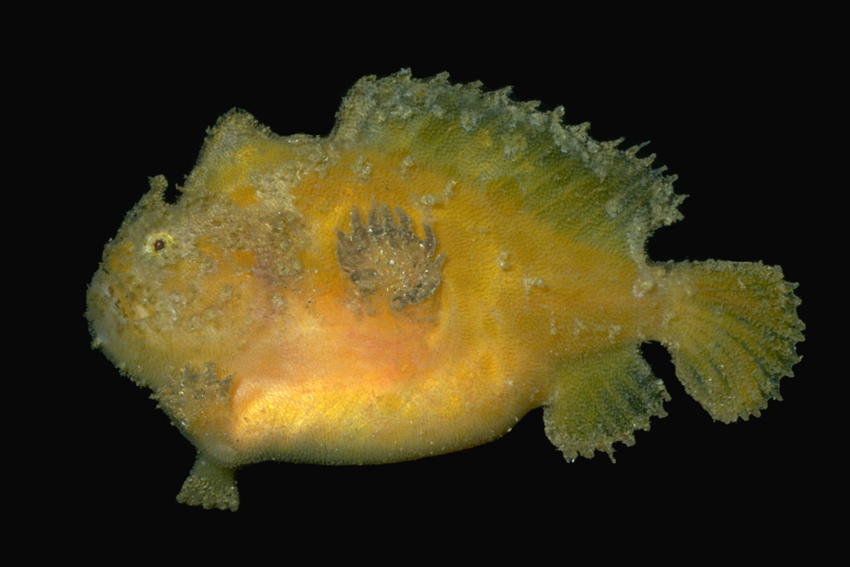Sponge Anglerfish, Echinophryne reynoldsi Pietsch & Kuiter 1984

A Sponge Anglerfish, Echinophryne reynoldsi. Source: Rudie Kuiter / Aquatic Photographics. License: All rights reserved
A small anglerfish with a short, deep body densely covered in tiny spinules, a short tail base, and an illicium or 'fishing rod' without a distinct lure.
Sponge Anglerfish, Echinophryne reynoldsi Pietsch & Kuiter 1984
More Info
|
Distribution |
Endemic to temperate waters of southern Australia, from about Western Port, Victoria, to King George Sound, Western Australia. Sponge anglerfishes live on rocky reefs in association with sponges, at depths of 10-20 m. |
|
Features |
Body short, deep, tailbase short; illicium or 'fishing rod' without a distinct lure; body and fins densely covered in tiny divided (bifurcate) spinules of equal length. |
|
Size |
To 8 cm |
|
Colour |
Pale yellow to orange-brown often with many small ocelli, underside of head pale; irregular light greyish patches on head, above pectoral-fin base, at origin of dorsal fin, and on tail base; outer margins of fins greyish-white, sometimes with purplish-brown or pale brown borders. |
|
Feeding |
Anglerfishes are well-camouflaged ambush predators with their skin variously covered in spinules, filaments and other appendages to aid their camouflage. A specimen in the South Australian Museum reportedly regurgitated a squat lobster after being collected at Edithburgh Jetty. |
|
Biology |
The sexes are separate and fertilisation is external Females spawn large demersal eggs onto rocky surfaces. The males guard these developing eggs in a 'pocket' created between their body and curled tail. |
|
Conservation |
|
|
Etymology |
Echinophryne is from the Greek echinos, meaning 'sea urchin' or 'hedgehog', and phryne meaning toad. The species is named reynoldsi after Lou Reynolds who collected the holotype. |
|
Species Citation |
Echinophryne reynoldsi Pietsch & Kuiter, 1984, Rev. Française d'Aquar. Herp. 11(1): 24, figs. 1-3. Type locality: Portsea Hole, Port Phillip, Victoria, 20 m. |
|
Author |
Dianne J. Bray & Vanessa J. Thompson |
Sponge Anglerfish, Echinophryne reynoldsi Pietsch & Kuiter 1984
References
Allen, G.R., N.J. Cross, D.J. Bray & D.F. Hoese 2006. Antennariidae. pp. 637-646 in Beesley, P.L. & Wells, A. (eds). Zoological Catalogue of Australia. Volume 35 Australia : ABRS & CSIRO Publishing Parts 1-3 2178 pp.
Arnold, R.J. & T.W. Pietsch 2012. Evolutionary history of frogfishes (Teleostei: Lophiiformes: Antennariidae): A molecular approach. Molecular Phylogenetics and Evolution 62: 117-129.
Gomon, M.F., Glover, C.J.M. & Kuiter, R.H (eds) 1994. The Fishes of Australia's South Coast. Adelaide : State Printer 992 pp. 810 figs.
Hutchins, J.B. 2001. Checklist of the fishes of Western Australia. Records of the Western Australian Museum, Supplement 63: 9-50
Kuiter, R.H. 1993. Coastal Fishes of South-eastern Australia. Bathurst : Crawford House Press 437 pp.
Paxton, J.R., Hoese, D.F., Allen, G.R. & Hanley, J.E. (eds) 1989. Zoological Catalogue of Australia. Pisces: Petromyzontidae to Carangidae. Canberra : Australian Government Publishing Service Vol. 7 665 pp.
Pietsch, T.W. 1994. Family Antennariidae. pp. 285-297 figs 254-264 in Gomon, M.F., Glover, C.J.M. & Kuiter, R.H (eds). The Fishes of Australia's South Coast. Adelaide : State Printer 992 pp. 810 figs.
Pietsch, T.W. 2008. Antennariidae. pp. 364-374 in Gomon. M.F., Bray, D.J. & Kuiter, R.H (eds). Fishes of Australia's Southern Coast. Sydney : Reed New Holland 928 pp.
Pietsch, T.W. & Grobecker, D.B. 1987. Frogfishes of the World: Systematics, Zoogeography, and Behavioral Ecology. Palo Alto : Stanford University Press 420 pp.
Pietsch, T.W. & Kuiter, R.H. 1984. A new species of frogfish of the genus Echinophryne (Family Antennariidae) from southern Australia. Revue Française d'Aquariologie et Herpetologie 11(1): 23-26 figs 1-3
Thresher, R.E. 1984. Reproduction in reef fishes. T.F.H. Publications, Inc. Ltd., Neptune City, New Jersey. 399 p.


